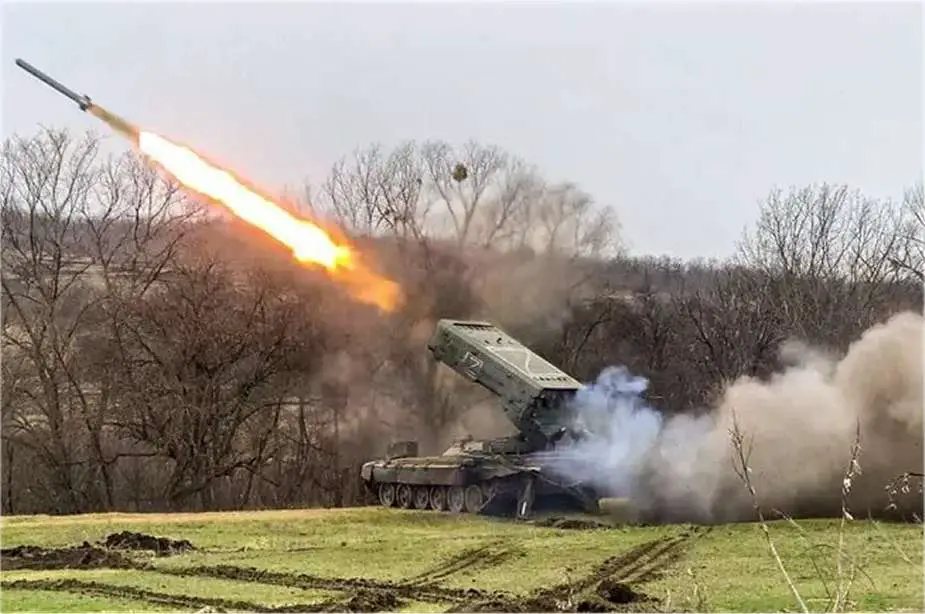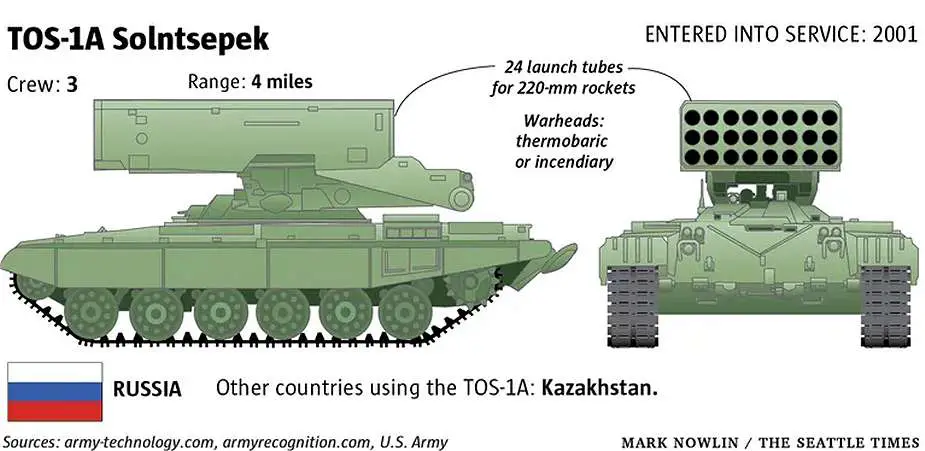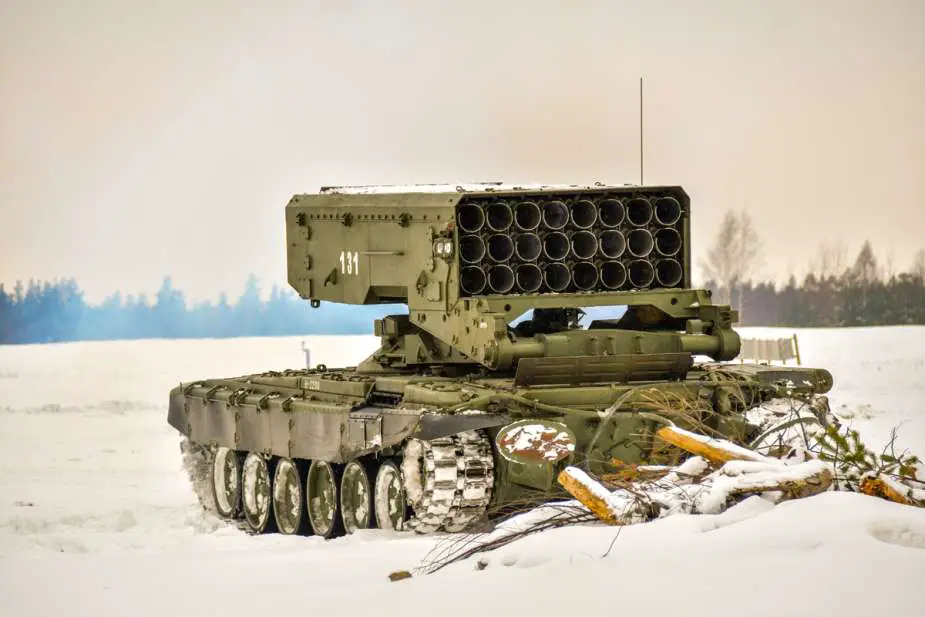In the ongoing Russian-Ukrainian Conflict, where strategy and firepower converge on the modern battlefield, Army Recognition is launching a comprehensive series of in-depth articles that scrutinize the military equipment used by Russian and Ukrainian forces. The inaugural episode focuses on the Russian TOS-1A thermobaric rocket launcher, a weapon that epitomizes the harrowing power and technological sophistication inherent in contemporary warfare
Follow Army Recognition on Google News at this link

The TOS-1A flamethrower thermobaric rocket launcher has been deployed by Russian forces in Ukraine since the beginning of the invasion in February 2022. (Picture source Russian MoD)
The TOS-1A, known as "Solntsepyok" (Scorching Sun), combines the mobility of a tank with the devastating firepower of a multiple rocket launcher system. It's mounted on a modified T-72 or T-90 tank chassis and can deliver thermobaric warheads that unleash a hellfire capable of obliterating fortified positions and personnel with a ruthless efficiency unmatched by conventional explosives. The TOS-1A is considered a terror weapon due to its destructive capabilities and the use of thermobaric rockets.
Introduced into service with improved capabilities in 2003, the TOS-1A had its range extended to 6 km. In 2020, Russia introduced a new rocket that further increased the system's range to 10 km, thanks to a new fuel-air explosive mixture in the warhead, while also boosting its power. The minimum range was extended from 400 to 1,600 meters, allowing for greater versatility in close combat environments.
Thermobaric weapons, also known as aerosol bombs or vacuum bombs, belong to a subclass of volumetric weapons that include fuel-air explosives. The lethality of thermobaric munitions lies in their two-stage detonation process. Initially, a fuel container disperses a cloud of fuel particles upon detonation. Subsequently, a second charge ignites the dispersed fuel and oxygen in the air, generating a blast wave of extreme pressure and heat. This blast wave is capable of reverberating with tremendous force, creating a partial vacuum in the area of impact. The effects are particularly devastating in enclosed spaces where the pressure and heat can be trapped, amplifying the damage.
Thermobaric ammunition's design enables it to obliterate fortified positions, dislodge entrenched forces, and clear extensive areas with its shockwave and fireball, which not only destroys material targets but also results in high lethality against personnel. The TOS-1A's thermobaric rockets, specifically the 173 kg MO.1.01.04 and the heavier 217 kg MO.1.01.04M variants, epitomize this devastating capability. Capable of saturating a target area up to 40 km², these rockets create a deadly envelope of fire and pressure that can level buildings, obliterate fortifications, and neutralize enemy combatants with horrifying efficiency.
However, the use of such weapons has raised ethical and legal concerns, particularly regarding their impact on civilian areas. Thermobaric weapons' indiscriminate nature has led to debates over their compatibility with international humanitarian law, amid reports of civilian casualties and infrastructure destruction.
The TOS-1A fulfills a pivotal dual purpose. It stands as a formidable direct-fire support instrument for infantry and armored divisions, adept at swiftly eliminating enemy fortifications, bunkers, and dug-in positions, while concurrently exerting a profound psychological impact on adversaries through the fear and demoralization induced by its potential use. This dual capability not only degrades enemy morale and operational effectiveness but also enables the TOS-1A to rapidly deploy significant firepower, facilitating area denial and propelling breakthroughs along otherwise static front lines.
In the Russian-Ukrainian conflict context, the TOS-1A fulfills both a tactical and psychological role, offering direct fire support to destroy fortifications and demoralize opponents. It excels in delivering massive firepower quickly for area denial and in breaking stalemates. In urban warfare, its precision minimizes collateral damage while effectively targeting enemy strongholds. The Russian military's deployment of about 50 TOS-1A and TOS-2 units in Ukraine, as reported by "Top War," highlights their role as among the most devastating, utilizing thermobaric rockets for enhanced blast effects in entrenched and urban scenarios.
In the complexity of urban warfare, where traditional artillery's effectiveness is diminished by the imperative of precise targeting to mitigate collateral damage, the TOS-1A emerges as a critical asset. Its utilization enables forces to methodically clear out enemy-held structures and fortified locales, showcasing its versatility and strategic value in dense, built-up environments.
The TOS-1A has been actively deployed, demonstrating its critical role in Russia's military strategy. The system was sighted on various fronts, indicating its widespread use across different stages of the conflict. Notably, Ukrainian forces have managed to capture several TOS-1A units, turning the tide by utilizing captured equipment against their adversaries. Such captures are a testament to the intense and dynamic nature of the conflict, showcasing the fluidity of control over sophisticated weaponry.


The TOS-1A is considered a terror weapon due to its destructive capabilities and the use of thermobaric rockets. (Russian MoD)
News Russia Ukraine War
















